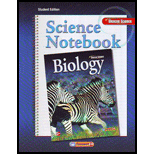
Concept explainers
To Explain:
The term
Introduction:
To catalyze chemical reaction enzymes are bind to one or more reactant molecules. These molecules are substrates of the enzymes, after that the reaction moves forward and converts the substrate into products. At the end of the reaction, products leave the active site of an enzyme.
Explanation of Solution
- Chemical reaction: A chemical reaction is a process in which two or more substances interact with new products. Substances are either compounds or chemical elements. Chemical elements that interact to produce new compounds are known as reactants and the new compounds called as products.
- Reactants: The elements that move forward into chemical reactions known as reactants. For example, in the burning of natural gas, methane and oxygen are reactants, and carbon dioxide and water are products produced in the reaction.
- Products: A product is an element that is produced as the outcome of a chemical reaction. The reaction starts with reactants that interact with each other. For example, nitrogen gas hydrogen gas is the reactant that reacts to produce ammonia as a product.
- Activation energy: Activation energy is the minimum amount of energy required by a molecule to get a new product. For example to start a car engine need activation energy
- Catalyst: Catalyst is a substance that adds to a reaction for increasing the
rate of a reaction without changing itself in the process. It allows to lower the activation energy and also changes the energy of the transition state.. - Enzyme: An enzyme is a biocatalyst that increases the rate of chemical reaction without itself being changed in the overall process. Most enzyme are proteins and highly specific for their substrate.
- Substrate: A substrate is a substance that reacts to the active site of an enzyme. A
chemical bond is formed between the substrate and the active site. The phenomenon in which the enzyme activates the specific substrate is known as substrate specificity. Therefore, the substrates are loaded in that active site so that comparatively weaker bonds can be forms between them. Example lactose. - Active site: This is a site on an enzyme where the substrate binds to the enzyme by multiple weak non covalent interactions such as hydrogen bond, hydrophobic bond, ionic interaction or reversible covalent bonds.
N2+ 3H2 → 2NH3
Hence, the term chemical reaction, reactant, product, activation, catalyst, enzyme, substrate, and active site are closely related to each other.
Chapter 6 Solutions
Biology Science Notebook
Additional Science Textbook Solutions
Biological Science (6th Edition)
Genetic Analysis: An Integrated Approach (2nd Edition)
Campbell Essential Biology (7th Edition)
Campbell Biology: Concepts & Connections (8th Edition)
Anatomy & Physiology (6th Edition)
Campbell Essential Biology with Physiology (6th Edition)
 Human Anatomy & Physiology (11th Edition)BiologyISBN:9780134580999Author:Elaine N. Marieb, Katja N. HoehnPublisher:PEARSON
Human Anatomy & Physiology (11th Edition)BiologyISBN:9780134580999Author:Elaine N. Marieb, Katja N. HoehnPublisher:PEARSON Biology 2eBiologyISBN:9781947172517Author:Matthew Douglas, Jung Choi, Mary Ann ClarkPublisher:OpenStax
Biology 2eBiologyISBN:9781947172517Author:Matthew Douglas, Jung Choi, Mary Ann ClarkPublisher:OpenStax Anatomy & PhysiologyBiologyISBN:9781259398629Author:McKinley, Michael P., O'loughlin, Valerie Dean, Bidle, Theresa StouterPublisher:Mcgraw Hill Education,
Anatomy & PhysiologyBiologyISBN:9781259398629Author:McKinley, Michael P., O'loughlin, Valerie Dean, Bidle, Theresa StouterPublisher:Mcgraw Hill Education, Molecular Biology of the Cell (Sixth Edition)BiologyISBN:9780815344322Author:Bruce Alberts, Alexander D. Johnson, Julian Lewis, David Morgan, Martin Raff, Keith Roberts, Peter WalterPublisher:W. W. Norton & Company
Molecular Biology of the Cell (Sixth Edition)BiologyISBN:9780815344322Author:Bruce Alberts, Alexander D. Johnson, Julian Lewis, David Morgan, Martin Raff, Keith Roberts, Peter WalterPublisher:W. W. Norton & Company Laboratory Manual For Human Anatomy & PhysiologyBiologyISBN:9781260159363Author:Martin, Terry R., Prentice-craver, CynthiaPublisher:McGraw-Hill Publishing Co.
Laboratory Manual For Human Anatomy & PhysiologyBiologyISBN:9781260159363Author:Martin, Terry R., Prentice-craver, CynthiaPublisher:McGraw-Hill Publishing Co. Inquiry Into Life (16th Edition)BiologyISBN:9781260231700Author:Sylvia S. Mader, Michael WindelspechtPublisher:McGraw Hill Education
Inquiry Into Life (16th Edition)BiologyISBN:9781260231700Author:Sylvia S. Mader, Michael WindelspechtPublisher:McGraw Hill Education





